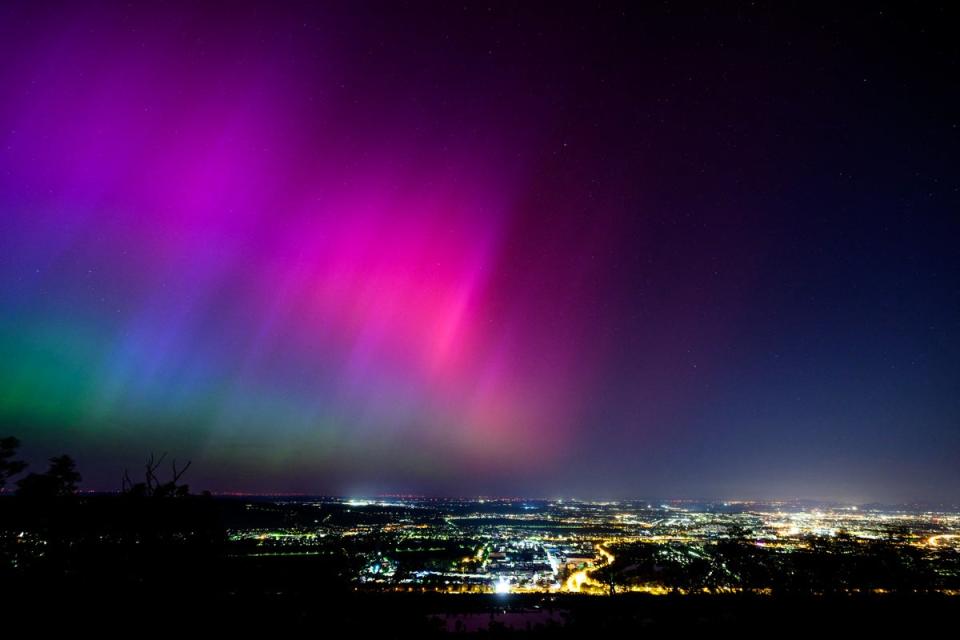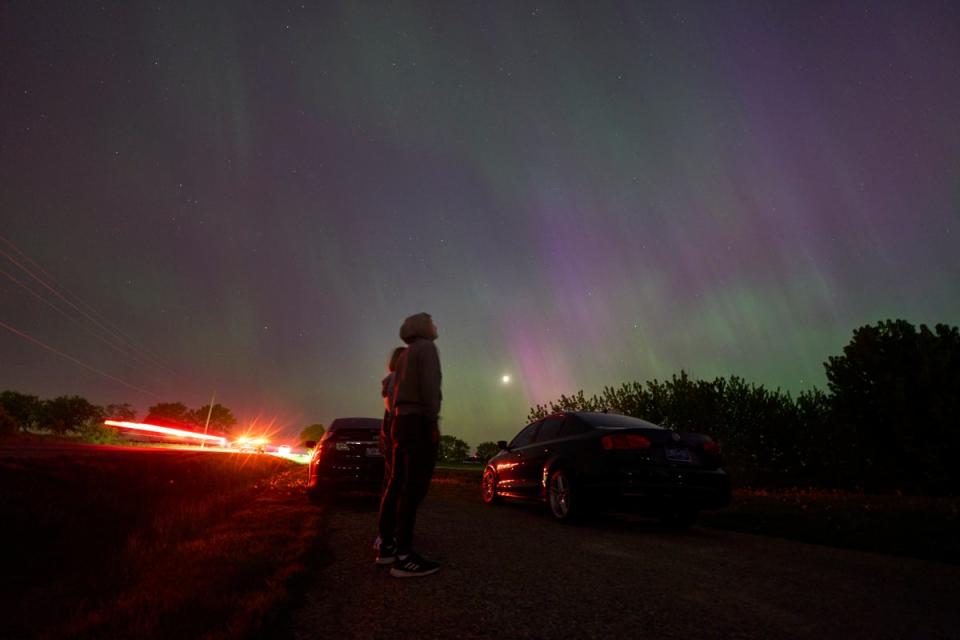Solar storm brings ‘stunning’ Northern Lights across UK skies
A powerful solar storm has led to a stunning and rare display of Northern Lights across the UK and the rest of Europe, with observers sharing images of the dazzling night sky on Friday.
Northern lights, also known as aurora borealis, could be spotted in Whitley Bay on the northeast coast, Essex, Cambridgeshire, Liverpool, Kent, Norfolk, with sightings as far south as Sussex.
People also reported catching the spectacle in central Europe, in countries such as the Czech Republic and Germany, after a severe solar storm hit the Earth’s atmosphere on Friday.
Friday’s celestial display was more pronounced due to a class 5 “extreme” geomagnetic storm, according to the US National Oceanic and Atmospheric Administration (NOAA).
The Northern Lights are vibrant curtains of light seen in the night sky, ranging from green to pink and scarlet. They are caused by charged particles from the sun interacting with gases in the Earth’s atmosphere.
The most spectacular displays happen when the sun releases large clouds of particles called “coronal mass ejections [CMEs]”.
“Aurora activity may remain enhanced after this, given the potential for further Earth-directed CMEs in the coming days,” the Met office noted.
Such geomagnetic storms are the strongest level to hit Earth, potentially affecting power grids, communications, and GPS.
The last time a solar storm hit Earth was in October 2003, when it caused power outages in Sweden.
I have never seen the #Aurora like that from the UK before. A truly stunning and historical event. These #NorthernLights images were taken tonight from Southern Oxfordshire UK!!! pic.twitter.com/S1etLbkSit
— VirtualAstro (@VirtualAstro) May 10, 2024
“I feel like I am having a religious experience – or an alien abduction. Not sure which,” science teacher from England, David Boyce wrote on X.
Aurora borealis tonight in Sheffield - absolutely breathtaking! #Auroraborealis #NorthernLights pic.twitter.com/3uMEe7ykLK
— Dr Franziska Kohlt 🦤 (@frankendodo) May 10, 2024
“It was absolutely stunning to see,” Kathleen Cunnea from Essex said.
Another user wrote on X: “Unbelievable, no words.”
Sightings were reported in Ireland as well, with the weather service Met Eireann posting images of the lights over Dublin and above Shannon airport in County Clare.
In the US, the aurora could be seen as far south as Alabama and southern California.
iPhone shots north of Toronto! #NorthernLights #Auroraborealis @TamithaSkov pic.twitter.com/B9a6O0e6Wz
— Nicole Mortillaro (@NebulousNikki) May 11, 2024
Several skywatchers in the US, UK, and many other parts of Europe took to social media to share their images of the dazzling sky.
The space weather phenomenon came due to at least four coronal mass ejections (CMEs), which are large amounts of plasma and magnetic flux emitted from the Sun.

Auroras occur when these charged particles from the Sun interact with gases in the Earth’s atmosphere as they travel along the planet’s magnetic field.
Time-lapse of tonight‘s Aurora from Nashville 🤩🤩🤩#Auroraborealis #aurora #Nashville #TN@SonyElectronics #Nightsky pic.twitter.com/nznmtgcntP
— Matt Tyska (@TyskaLabActual) May 11, 2024
When the intensity of the emission from the Sun is stronger, the display may reach a larger area, extending further South.
Surreal! Tall #aurora pillars amid the red arc dazzle the skies over Franklinton, Louisiana, USA during this ongoing G5-level #solarstorm. Im so pleased the lights have made their way south to you again! Thanks for capturing such a great shot. https://t.co/zgfvZZHNYP
— Dr. Tamitha Skov (@TamithaSkov) May 11, 2024
The effect is most pronounced near the Earth’s magnetic poles. In the northern hemisphere, auroras are typically seen between latitudes 60 and 75 degrees.
This is making me emotional! I never expected to see this in Alabama! pic.twitter.com/pGxz5Sm5gy
— Amber Kulick ⛈️ (@AmberKulick_wx) May 11, 2024
The Sun is currently at the height of its 11-year cycle known as the Solar Maximum when the number of sunspots and the intensity of solar activity is expected to reach a peak.
This means solar storms are likely to cause more auroras in the future.

“This solar storm did not disappoint, and it may not yet be over. Though this may be the strongest of them, there are still other storms still on their way to Earth,” space weather physicist Tamitha Skov posted on X.
“This means more spectacular displays over the next few days are possible! Thanks to all Space Weather field reporters, who shared their photos and moments like this tonight. You made this community magical!” she said.
Met office spokesman Stephen Dixon said that “conditions could continue on Saturday night, but we still have to work out some details on where exactly that will be”.

